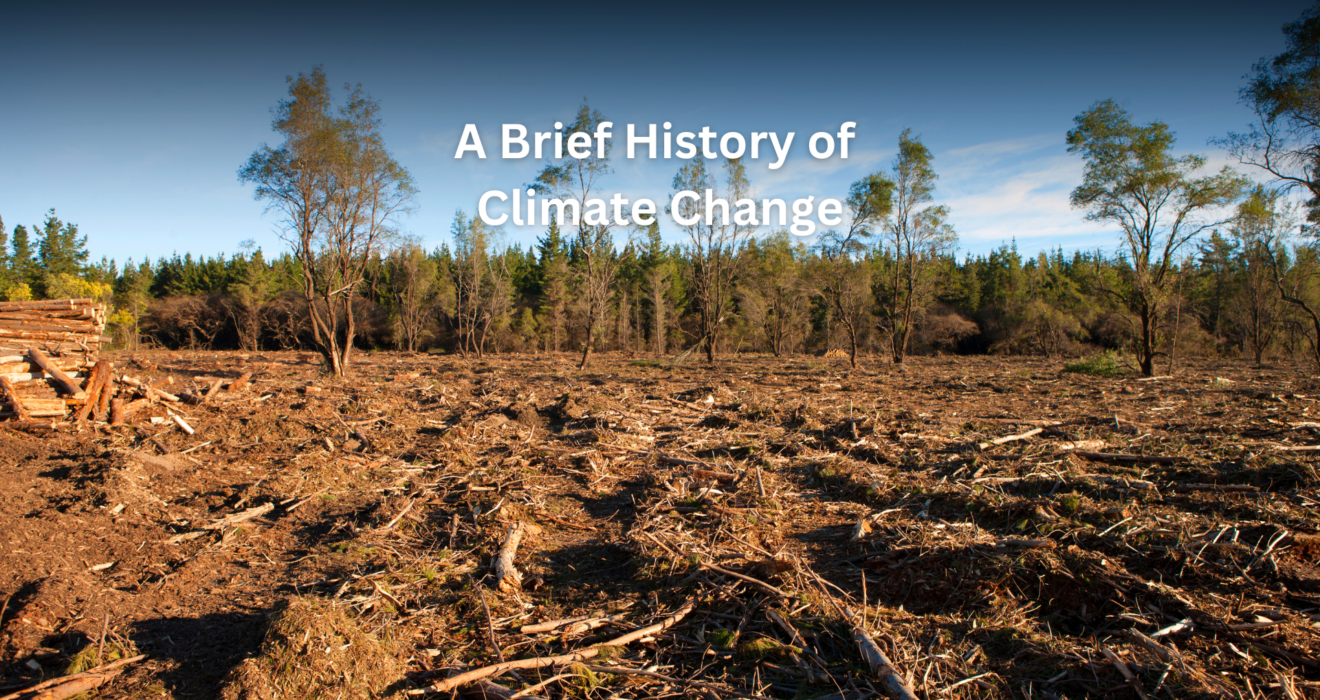“Don’t eat meat! The methane emissions harm the planet. Use public transport. Go vegan. Eat local.” The list goes on. These phrases have populated our daily lifestyle, social media, and education to ingrain the idea of taking better care of the planet. They are designed to make us conscious of the reality of climate change. But how did we come to this point?

Climate change is one of the major challenges we face today. It all started with the unparalleled growth of human civilization. Today, society stands at one of the greatest precipices of achievements. Life expectancy has increased across all age groups, and although it may not always feel like it, this is the most peaceful era in human history (based on war-related deaths), according to Harvard University psychologist Steven Pinker.
However, it has come at a cost that was not fully understood even a few decades ago as large-scale development took off. Climate change became a prominent news topic only about 32 years ago. As societies worldwide started experiencing the real-life impacts of climate change, the wake-up call occurred. Today, different communities are living through these very real consequences.
To understand this better, we need to know exactly what carbon emissions and greenhouse gases (GHGs) are.
What Are GHGs?
Greenhouse gases (GHGs) are gases that intensify the greenhouse effect, wherein they absorb heat energy from the Earth’s surface and radiate it back. This creates a blanket of heat over the planet, trapping rising heat from the surface in a greenhouse-like fashion (similar to how sunlight is trapped to encourage plant growth). The accumulation of GHGs in the atmosphere leads to global warming — the long-term rise in Earth’s temperature.
While carbon dioxide (CO2) is the most commonly discussed GHG, there are several others that are more potent. These include methane (CH4), nitrous oxide (N2O), and fluorinated gases.
However, not all GHGs are created equal when it comes to their warming effects. Methane has at least 28 times the global warming potential (GWP) of CO2, while N2O has 298 times the GWP, according to the latest IPCC Fifth Assessment Report. These GWP values are typically measured on a 100-year scale, meaning that over 100 years, 1 tone of methane will have 28 times the GWP of the same amount of CO2.
The Difference Between Global Warming and Climate Change

Though intricately linked, global warming and climate change are not interchangeable terms. Global warming refers to the gradual warming of our planet and is just one aspect of climate change. Climate change refers to shifts in Earth’s long-term climate stability. The Intergovernmental Panel on Climate Change (IPCC) defines climate change as “a change in the state of the climate that can be identified (e.g., using statistical tests) by changes in the mean and/or the variability of its properties, and that persists for an extended period, typically decades or longer.”
This change is not limited to an increase in temperature. It also includes other phenomena such as colder winters, unusual rainfall patterns, intensified natural disasters, and other extreme weather events.
While some level of climate change has always occurred throughout the planet’s history, the rise in atmospheric CO2 cannot be entirely attributed to natural processes. For example, Earth has undergone multiple ice ages, leading to gradual increases in atmospheric carbon dioxide over time. However, for the 800,000 years before the Industrial Revolution, the global average atmospheric CO2 level was around 280 ppm.
Then, everything changed. The rapid human expansion and growth since the Industrial Revolution, followed by the two World Wars, significantly accelerated innovation and consumption of natural resources. This led to the sudden spike in CO2 levels from the 1950s onward.
It is this shift in Earth’s climate over a short time, a change that breaks millennia of stable planetary CO2 levels, that is of such concern today, requiring urgent action to address climate change.
Paleoclimate Evidence
How do we measure the planet’s carbon levels, which span millennia?
Climate scientists have tools for this. One key method is examining ice cores, which contain air bubbles that provide a glimpse into the Earth’s climatic conditions from hundreds of thousands of years ago. This process, known as paleoclimate evidence, is crucial for understanding long-term climate patterns. Other methods for gauging past climates include analyzing coral reefs, tree rings, and ocean sediments, which also reveal valuable information about historical environmental stressors.
Implications
If GHGs are so potent, why don’t we stop emitting them? The globalization of human activities and their interconnectedness make this a complex issue. Almost every activity we do today has an impact on the environment.
Farming, transportation, manufacturing goods, using services — nearly every human activity involves emissions. Burning fossil fuels, deforestation, and unsustainable farming and livestock practices are some of the main human-induced causes of climate change. For example, something as simple as drinking milk can generate both carbon and methane emissions. This includes the CO2 emissions from transporting dairy and the methane emissions from raising cattle.
In the past century, methane is believed to have contributed to at least 20% of the planet’s warming, especially with the rise of livestock farming. Methane’s higher GWP has made it a major target for reduction, contributing to the rise of the plant-based food industry.

From melting ice caps to linked health issues, long-term changes in the planet’s natural order are harmful to all life forms. While humans may face challenges such as water scarcity, health problems, and ultimately a less habitable planet, other species face ecosystem destruction, food chain disruptions, and habitat loss, which may drive them to extinction.
Many communities are already bearing the brunt of these impacts. Recent climate change-exacerbated wildfires in California and the Western US made global headlines last week. According to the IPBES, 1 million species are already at risk of extinction, and a WWF report found that 68% of wildlife has declined due to human activity.
Tackling Climate Change
Governments, businesses, NGOs, and citizens alike have recognized the need to address climate change. International agreements such as the Paris Climate Agreement have brought countries together to target emission reductions and address related environmental issues like biodiversity loss. These efforts aim to mitigate the long-term effects of climate change for the survival of both humanity and wildlife.
Here are some initiatives that highlight the increasing action being taken to manage climate change:
- Fossil Fuel Divestment: According to a 2017 study by the Carbon Disclosure Project, 100 major fossil fuel companies are responsible for 71% of global emissions since 1988. The good news is that several banks and investment firms, including the European Investment Bank, JPMorgan Chase, and BlackRock, have committed to stopping investments in fossil fuel projects like Arctic drilling and new coal power plants.
- Carbon Neutrality: Many tech companies are committing to carbon neutrality. Google, Facebook, Apple, and Microsoft are working towards achieving carbon-neutral status, meaning they will balance their carbon emissions by adopting renewable energy, planting trees, and purchasing carbon credits.
- Smart Cities: With over 50% of the global population expected to live in cities by 2050, governments are promoting smart, sustainable cities. In India, the Smart Cities Mission aims to balance development and biodiversity conservation, emphasizing sustainable urban growth while maintaining environmental integrity.
- Alternative Meat Consumption: The plant-based food industry continues to grow. Major fast-food chains like Burger King and Dunkin Donuts are offering plant-based alternatives. In 2019, alternative meat companies saw record investments of $824 million, with 2020 breaking that record with $930 million invested in Q1 alone.
- Ozone Recovery: Efforts to phase out CFCs and HCFCs (fluorinated gases) under the Montreal Protocol in 1987 have been successful. Recent studies show that the ozone hole is beginning to recover, thanks to these actions (NASA).
The Need for More Action
Despite these advances, more action is needed. While it may be impossible to eliminate emissions completely, they can be significantly reduced, especially in certain industries. The development of new, groundbreaking technologies is accelerating, but high costs are often a barrier to their widespread adoption. To truly address climate change, we need economically viable solutions for scaling up carbon-reduction technologies.
Nature-based solutions (NbS) have emerged as a promising approach to mitigating climate change. By harnessing nature’s power, such as reforestation and restoring wetlands, we can complement man-made solutions to tackle environmental challenges. At Terracon Ecotech, we integrate NbS into various industries across India, helping them meet their environmental goals.
Click below to book a demo to learn more about Nature-based Solutions!
References:
- National Geographic: Climate Change First Became News 30 Years Ago. Why Haven’t We Fixed It?
- IPCC Fifth Assessment Report Chapter 8
- NOAA: Climate Change Atmospheric Carbon Dioxide
- NOAA: What is Paleoclimatology?
- National Geographic: Methane Facts and Information
- CNN: Human activity has wiped out two-thirds of world’s wildlife since 1970, landmark report says
- Carbon Disclosure Project: Carbon Majors Database
- Guardian: Facebook and Google announce plans to become Carbon Neutral
- GFI: Media Release





